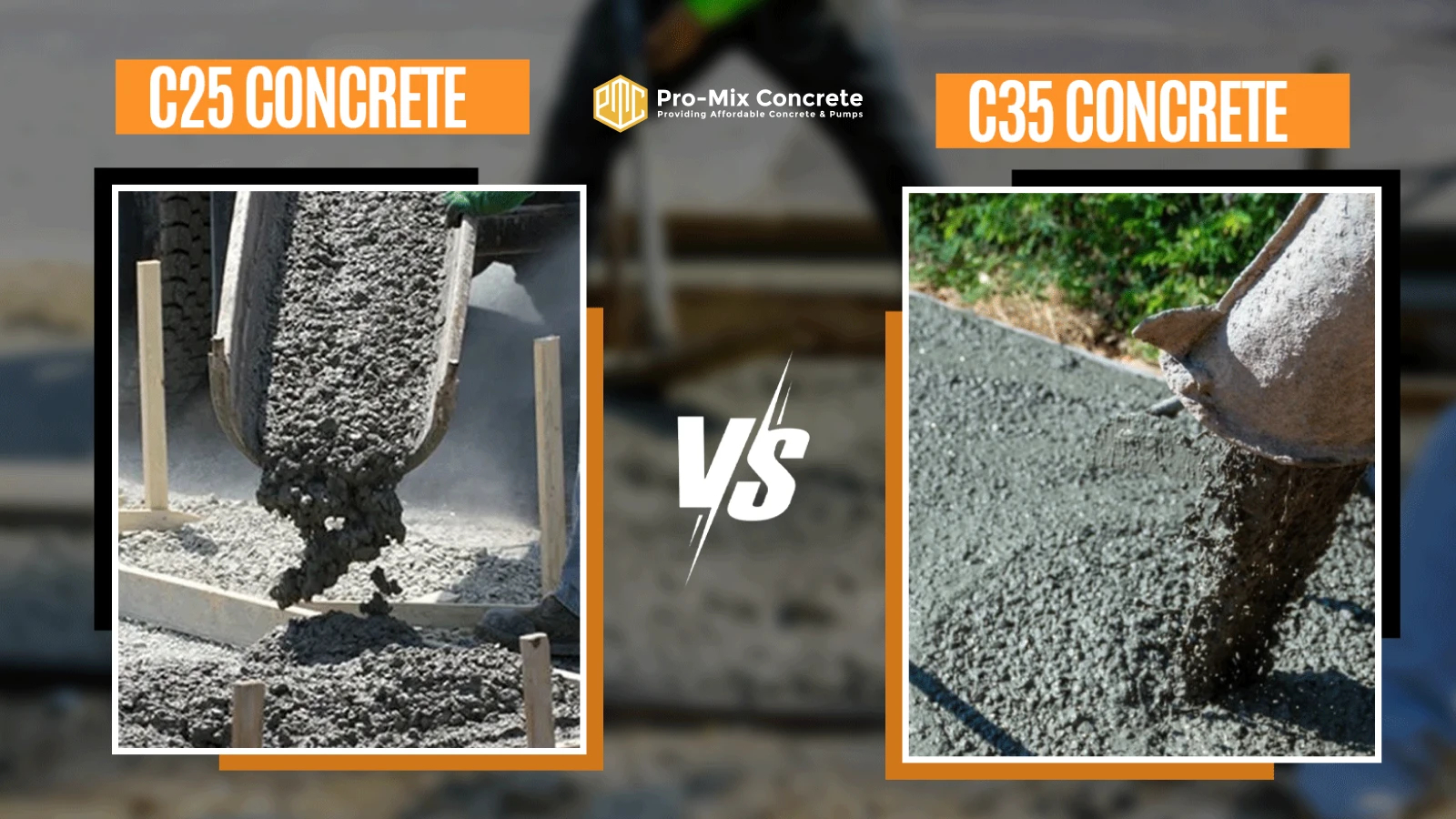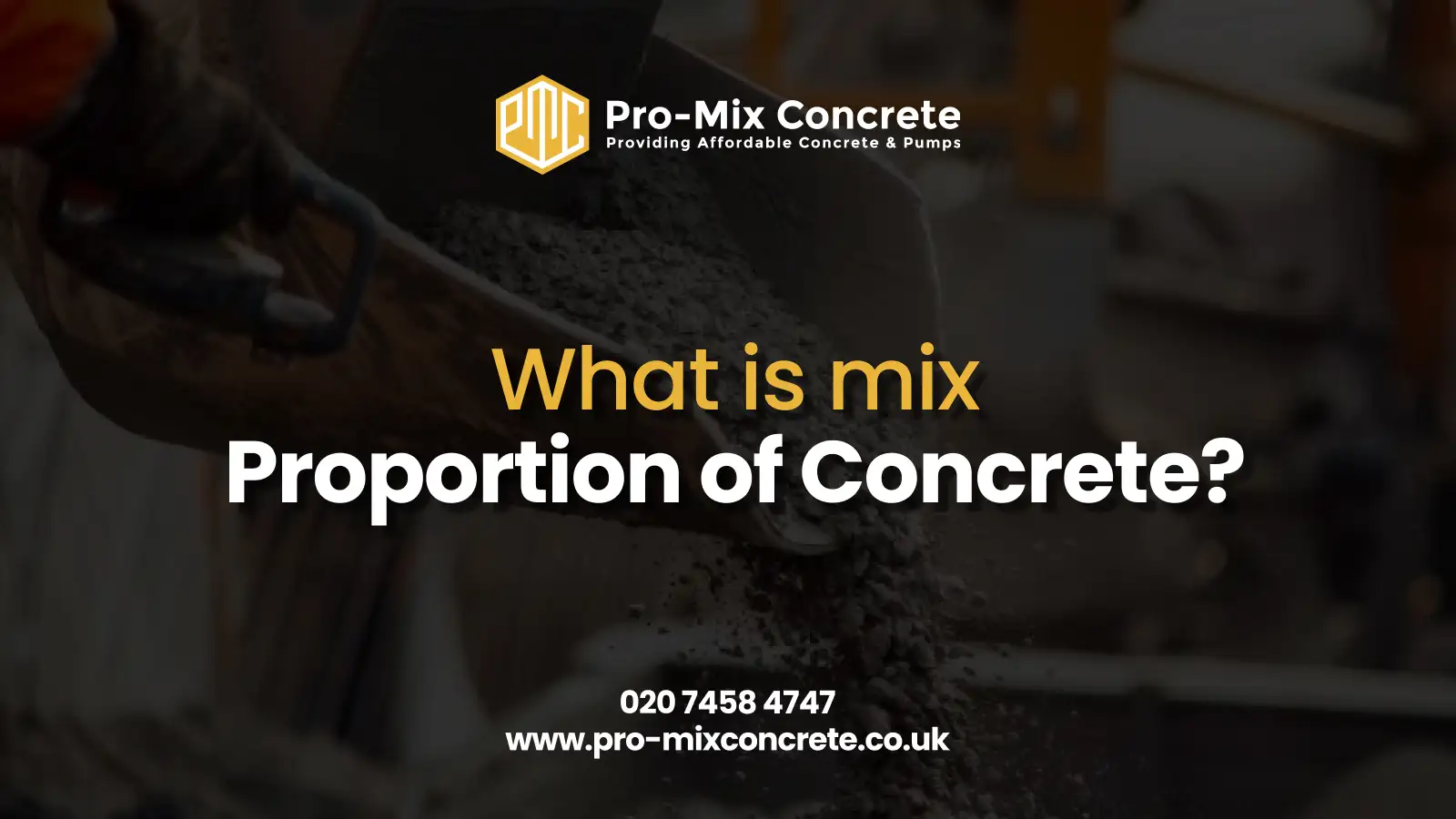Concrete forms the foundation of modern construction, quite literally. Different construction projects demand different concrete strengths, and selecting the wrong mix can lead to structural problems, excessive costs, or even safety hazards.
Among the most commonly compared concrete grades are C25 and C35. These numerical designations might seem like simple code to the uninitiated, but they represent significant differences in strength, durability, and application potential. C25 concrete has a characteristic compressive strength of 25 N/mm² (MPa) after 28 days of curing. On the other hand, C35 concrete reaches 35 N/mm² (MPa) in the same period, making C35 stronger than C25 in terms of compressive strength.
Understanding the differences between these two popular concrete grades helps builders, engineers, and even DIY enthusiasts make informed decisions that balance cost, workability, and performance requirements. The right choice depends on various factors, including load-bearing needs, exposure to harsh conditions, project budget, and the intended lifespan of the structure.
Understanding Concrete Grades
Concrete classification follows a standardised system based on compressive strength testing. Engineers determine the appropriate concrete grade by considering the structural loads and environmental conditions the concrete will face.
The classification system ranges from C8/10 for the weakest non-structural concrete to C100/115 for ultra-high-strength applications. The first number represents the characteristic cylinder strength, while the second represents the cube strength.
The “C” in both C25 and C35 stands for “Concrete,” while the numbers represent the concrete’s characteristic compressive strength measured in newtons per square millimetre (N/mm²) or megapascals (MPa) after 28 days of curing. This curing period is the industry standard for measuring concrete strength, as it gives the material sufficient time to reach a significant portion of its ultimate strength.
In simple terms:
- C25 concrete will withstand 25 N/mm² of pressure before failing
- C35 concrete will withstand 35 N/mm² of pressure before failing
For residential and common commercial applications, C20/25 (commonly referred to as just C25) and C30/37 (C35) are among the most widely used grades. Both C25 and C35 concrete have a mass density of around 2300 kg/m³, but their strength differences make them suitable for different applications.
Mix Ratios and Composition
Standard Mix Ratios for C25 and C35
The strength of concrete comes from its specific mix of components. The typical mix ratios for these grades are:
C25 Concrete Mix Ratio:
- 1 part cement
- 2 parts sand
- 4 parts aggregate
- Water-cement ratio of approximately 0.5-0.6
C35 Concrete Mix Ratio:
- 1 part cement
- 2 parts sand
- 3 parts aggregate
- Water-cement ratio of approximately 0.45-0.5
The lower water-cement ratio in C35 contributes significantly to its higher strength. Less water means fewer voids in the concrete after curing, resulting in a denser, stronger material.
Key Ingredients and Their Roles
Each component in the concrete mix serves a specific purpose:
- Cement: The binding agent that reacts with water to create a paste that glues the mixture together. C35 typically contains more cement than C25.
- Sand (Fine Aggregate): Fills spaces between larger aggregates and improves workability. The quality and grading of sand affects the concrete’s finished properties.
- Gravel/Crushed Stone (Coarse Aggregate): Provides bulk and strength to the concrete. Higher quality, properly sized aggregate contributes to stronger concrete.
- Water: Activates the chemical reaction with cement (hydration) that causes hardening. The water-cement ratio is crucial, as too much water weakens concrete.
- Admixtures (Optional): Chemical additives that modify concrete properties like setting time, workability, or freeze-thaw resistance. C35 more commonly includes admixtures for specialised performance.
The precise balance of these ingredients determines not only strength but also workability, durability, and other performance characteristics.
Strength and Performance Comparison
Compressive Strength: C25 vs. C35
As mentioned earlier, C25 concrete has a characteristic compressive strength of 25 N/mm² (MPa) after 28 days of curing, while C35 concrete reaches 35 N/mm² (MPa) in the same period. This makes C35 approximately 40% stronger than C25 in terms of compressive strength.
This strength difference significantly impacts where and how each concrete grade can be used:
- C25 is sufficient for many residential applications where extreme loads aren’t expected
- C35 is preferred for commercial structures or areas with higher stress requirements
It’s important to note that both grades continue to gain strength beyond the standard 28-day testing period, potentially reaching 10-15% higher compressive strength after several months.
Durability and Longevity
Strength is just one aspect of concrete performance. Durability is the ability to withstand environmental conditions without degrading, and it is equally important:
- Freeze-Thaw Resistance: C35’s denser structure makes it more resistant to damage from repeated freezing and thawing cycles. Water that penetrates concrete expands when frozen, and C35’s lower permeability reduces this water infiltration.
- Chemical Resistance: The higher cement content and lower water-cement ratio in C35 create a less porous concrete that better resists chemical attacks from road salts, sulfates in soil, or acid rain.
- Abrasion Resistance: High-traffic areas benefit from C35’s improved resistance to surface wear. This makes it more suitable for driveways, warehouse floors, and other areas subject to friction and impact.
- Reinforcement Protection: C35 provides better protection against carbonation (a process that can lead to reinforcement corrosion) due to its lower permeability, making it preferable for reinforced concrete exposed to air.
These durability advantages often mean C35 concrete structures require less maintenance and have longer service lives compared to equivalent C25 structures.
Typical Applications
Common Uses for C25 Concrete
C25 concrete finds its place in numerous applications where moderate strength is sufficient:
- Residential foundations for single-story structures
- Garden paths and patios
- Domestic driveways with light vehicle traffic
- Internal floor slabs are not subject to heavy loads
- Backyard sheds and small outbuildings
- Concrete fence posts and garden walls
- Interior concrete countertops and decorative elements
These applications typically don’t face extreme loading conditions or harsh environmental exposure, making C25 a cost-effective choice.
Common Uses for C35 Concrete
C35 concrete is typically specified for more demanding applications:
- Foundations for multi-story buildings
- Commercial driveways and loading areas
- Bridge supports and abutments
- Retaining walls over 1.5 meters high
- Swimming pools and water-retaining structures
- Agricultural buildings with heavy machinery traffic
- External slabs exposed to freeze-thaw cycles
- Marine structures with saltwater exposure
The higher strength and improved durability of the C35 make it the preferred choice for these more challenging scenarios.
3 Primary Factors to Consider When Choosing a Mix
1. Load Requirements
The anticipated loads on your concrete structure should be your primary consideration:
- Dead loads: The permanent weight of the structure itself
- Live loads: Temporary or movable weights (people, furniture, vehicles)
- Environmental loads: Snow, wind, earthquake forces
- Dynamic loads: Vibrations from machinery or traffic
Higher anticipated loads generally call for stronger concrete, like C35. Engineers calculate these loads and specify minimum concrete strengths accordingly, often with built-in safety factors.
2. Environmental Conditions
The environment where concrete will be placed greatly affects which grade is appropriate:
- Freeze-thaw cycles: Regions with frequent freezing and thawing need more durable concrete (C35)
- Chemical exposure: Areas near saltwater, industrial pollutants, or de-icing salts benefit from C35’s lower permeability
- Temperature extremes: Very hot or cold climates may require special considerations for either grade
- Moisture levels: Constantly wet environments accelerate the degradation of lower-grade concretes
C35’s greater durability makes it more suitable for harsh environments, while C25 may suffice in protected or mild conditions.
3. Project Type (Residential, Commercial, Industrial)
Different project categories typically have different requirements:
- Residential Projects: Often have lower loading requirements and may prioritise cost savings, making C25 suitable for many applications. However, elements like driveways in cold climates may warrant C35.
- Commercial Projects: Usually face higher traffic, more significant loads, and higher liability concerns, pushing specifications toward C35 for main structural elements.
- Industrial Projects: Nearly always require C35 or stronger due to heavy equipment, chemical exposure, and the high cost of downtime if repairs become necessary.
Local building codes often specify minimum concrete strengths for different project types, but wise builders sometimes exceed these minimums for added durability and peace of mind.
Cost and Workability
Material Costs for C25 vs. C35
The price difference between C25 and C35 typically ranges from 10-15%, with C35 being the more expensive option. This cost difference comes primarily from:
- Higher cement content in C35
- Potential need for admixtures in C35
- More stringent quality control requirements
- Greater testing frequency during production
The cost difference might be $500-$1,000 for a typical residential project like a 100m² driveway, which could be insignificant compared to the total project cost but substantial for budget-conscious homeowners.
When evaluating costs, consider not just the initial expense but also the long-term maintenance costs and potential lifespan of the structure. C35’s greater durability often makes it more economical over the full life cycle of a structure, especially in demanding conditions.
Ease of Mixing, Pouring, and Finishing
Workability differences between the two grades can impact labour costs and installation quality:
C25 Workability:
C25 concrete offers superior workability that benefits both professionals and DIY enthusiasts. It mixes easily with basic equipment and forgives minor variations in water content without significantly affecting strength.
With longer setting times, crews have more flexibility during placement and finishing. C25 flows better into complex forms and requires less vibration to fill spaces properly, making it accessible even to those with limited concrete experience.
C35 Workability:
C35 concrete demands more precision during installation. Mixing requires careful measurement and more powerful equipment, with little room for error in the water-cement ratio. Most C35 mixes need admixtures like plasticisers to achieve proper flow without compromising strength.
Its quicker setting time necessitates efficient placement, while finishing requires skilled techniques to ensure a durable surface. These challenges make C35 less suitable for inexperienced workers or DIY projects.
Pros and Cons of Each Mix
Pros and Cons of C25
Pros of C25:
- The more affordable initial cost
- Easier to work with for DIY projects
- Adequate strength for many residential applications
- More widely available from small-batch suppliers
- More forgiving mixing and placement process
- Less cement means a lower carbon footprint
Cons of C25:
- Insufficient strength for heavily loaded structures
- Less durable in harsh environmental conditions
- Higher maintenance costs in the long run
- More vulnerable to cracking and deterioration
- May not meet code requirements for certain applications
- Shorter expected service life in challenging conditions
Pros and Cons of C35
Pros of C35:
- Significantly higher strength for demanding applications
- Better durability in harsh environments
- Lower permeability reduces water and chemical penetration
- Better protection for embedded reinforcement
- Typically longer service life with less maintenance
- Often more economical over the structure’s lifetime
Cons of C35:
- Higher initial material cost
- More challenging to mix and place correctly
- Usually requires professional installation
- Less forgiving if mistakes are made during placement
- May crack if proper curing procedures aren’t followed
- Higher carbon footprint due to increased cement content
Best Practices for Selection
Guidelines for Engineers and Builders
Follow these best practices when deciding between C25 and C35:
- Consult local building codes first, as they may specify minimum concrete grades for certain applications
- Consider future use changes because selecting a stronger grade now might accommodate later modifications
- Factor in the full lifecycle cost, not just the initial expense
- Get soil tests for foundation work to identify potential chemical exposure
- Analyse local climate data to assess freeze-thaw risk and other environmental factors
- Consult material suppliers about local aggregates that might affect performance
- Review similar local projects and their concrete performance over time
These considerations help ensure that your concrete grade selection matches both current requirements and future needs.
Mistakes to Avoid
Common errors when selecting concrete grades include:
- Underspecifying the concrete grade to save money, leading to premature failures
- Overspecifying the concrete grade unnecessarily wastes resources
- Ignoring environmental exposure that might degrade lower-grade concrete
- Failing to consider drainage around concrete structures
- Not planning for proper curing can undermine even high-grade concrete
- Assuming all projects need the highest strength without proper analysis
- Neglecting to consult structural engineers for complex applications
Avoiding these mistakes helps ensure that your concrete performs as expected throughout its service life.
Summary Table: C25 vs. C35 at a Glance
Feature | C25 Concrete | C35 Concrete |
Compressive Strength | 25 N/mm² (MPa) | 35 N/mm² (MPa) |
Density | Approximately 2300 kg/m³ | Approximately 2300 kg/m³ |
Typical Water-Cement Ratio | 0.5-0.6 | 0.45-0.5 |
Relative Cost | Lower (baseline) | 10-15% higher |
Typical Applications | Residential, light-duty | Commercial, structural |
Durability in Harsh Conditions | Moderate | Good to excellent |
DIY Suitability | Good | Limited |
Expected Service Life | 30-50 years | 50-100 years |
Environmental Impact | Lower | Higher |
Final Call
Choosing between C25 and C35 concrete ultimately depends on balancing strength requirements, environmental exposure, budget constraints, and long-term performance expectations. In general:
Choose C25 when:
- The application involves non-structural or lightly loaded elements
- The concrete will be in a protected environment
- Budget constraints are significant
- DIY installation is planned
- The project is residential with standard loading
Choose C35 when:
- Structural integrity is critical
- The environment includes freeze-thaw cycles or chemical exposure
- Long-term durability is worth the additional upfront cost
- Professional installation is already planned
- The project is commercial or industrial
At Pro-Mix Concrete, our precisely engineered C25 and C35 mixes are formulated with locally sourced, premium aggregates and advanced admixtures that outperform industry standards.
Our customers tell us what sets us apart isn’t just our premium mixes (though our locally sourced aggregates do make a difference). It’s that we take the time to understand your project before recommending C25 or C35. Why pay extra for C35 if C25 will do the job perfectly? And why risk using C25 when your project really needs C35’s strength?
Get in touch with our experts to talk about your needs. No sale pitches, just straight talk about concrete from people who genuinely love what they do!
Frequently Asked Questions
Yes, C25 concrete is suitable for the foundations of single or two-story residential buildings in most soil conditions. However, if your site has expansive soil, high water tables, or freeze-thaw concerns, C35 provides better long-term performance. Local building codes often specify minimum concrete strengths for foundations, so check these requirements before deciding.
C35 concrete typically costs 10-15% more than C25. For example, if C25 costs $110 per cubic meter, C35 would likely cost $120-$125 per cubic meter. This price difference mainly comes from the additional cement content and potential admixtures in C35. However, when considering lifetime costs including maintenance and longevity, C35 often proves more economical for structures in challenging environments.
While you can improve C25’s performance somewhat through proper curing and admixtures, you cannot transform it into true C35 concrete after mixing. The fundamental difference lies in the mix design, particularly the cement content and water-cement ratio. If your project requires C35 strength, it’s better to use the proper mix from the start rather than trying to enhance a lower-grade concrete.
Request delivery tickets that show the mix design and strength class. Reputable concrete suppliers provide documentation specifying the concrete grade. For critical applications, consider hiring a third-party testing company to take sample cylinders during pouring. These cylinders are tested at 7 and 28 days to verify that the concrete meets specified strength requirements.
- Dennis Broderick
- Dennis Broderick is the founder and owner of Pro-Mix Concrete Company, a trusted name in ready-mix concrete solutions across the UK. With over 20 years of hands-on experience in the construction and concrete industry, Dennis brings unmatched expertise, practical insights, and a commitment to quality on every project - from residential driveways to large-scale commercial developments.
BlogNovember 15, 2025What is the Mix Proportion of Concrete?
BlogOctober 30, 2025Same-Day and Next-Day Delivery Options from London Concrete Suppliers
BlogOctober 28, 2025Line Pump Hire vs. Boom Pump Hire Prices in London
BlogOctober 25, 2025How Quickly Concrete Must Be Used Once Delivered In London Traffic









